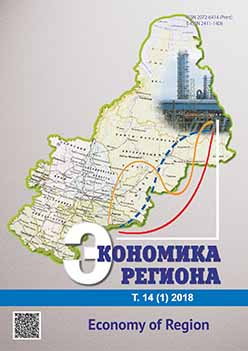Методический инструментарий оценки благосостояния населения: межрегиональное сопоставление
Methodological Tools to Assess the Population Welfare: Interregional Comparison
Author(s): Svetlana Nikolaevna Naiden, Anna Vasilyevna BelousovaSubject(s): Economy, Geography, Regional studies
Published by: Институт экономики Уральского отделения Российской академии наук
Keywords: welfare of the population; quality of life; inequality; index; ranking; econometric modeling; hierarchy analysis method; region; subject of the Russian Federation; Far East;
Summary/Abstract: The article considers the current problem of the assessment of the level of human wellbeing in the Russian regions. The research identifies the features of application of traditional tools to the assessment of welfare in the conditions of spatial heterogeneity. However, modernizing these tools allows to show the real quality of life in the regions. On the example of the multidimensional index of welfare, we test the hypothesis that the position of a region in spatial selection can vary depending on various combinations of indicators as a part of the integrated indicator. At the first stage, the authors calculate the multidimensional index of welfare in the subjects of the Russian Federation for three various sets of indicators. At the second stage, we estimate the dependences of indexes on their indicators. It allows defining the potential conditions for upgrading the position of each subject of the Far East in terms of welfare among other Russian regions. At the third stage, we assess the influence of initial indicators on the integrated index of population welfare on the basis of an hierarchy analysis method of T. Saati. This method allowed estimating local priorities for each Far East region. The received estimates have allowed to select the most significant indicators (job, income, and housing. Furthermore, we have offered a three-factorial integrated indicator of the population welfare reflecting the evaluation of individual prosperity. The interregional comparisons have shown that the northern regions of the Far East remain leaders in terms of the most significant factors of basic welfare, but not in terms of comfort. The regions of the southern zone of the Far East with more favourable conditions for life remain outsiders in terms of the prosperity level, but have a considerable potential for enterprise activity. Khabarovsk Krai holds the most advantageous position according to the integrated index of welfare. This region combines the functions of the capital and transport and logistic functions. The received conclusions adequately reflect a real situation and can be useful for the assessment of efficiency. The research results can be applied to define the priority directions of the development of the Far East regions.
Journal: Экономика региона
- Issue Year: 14/2018
- Issue No: 1
- Page Range: 53-68
- Page Count: 15
- Language: Russian

